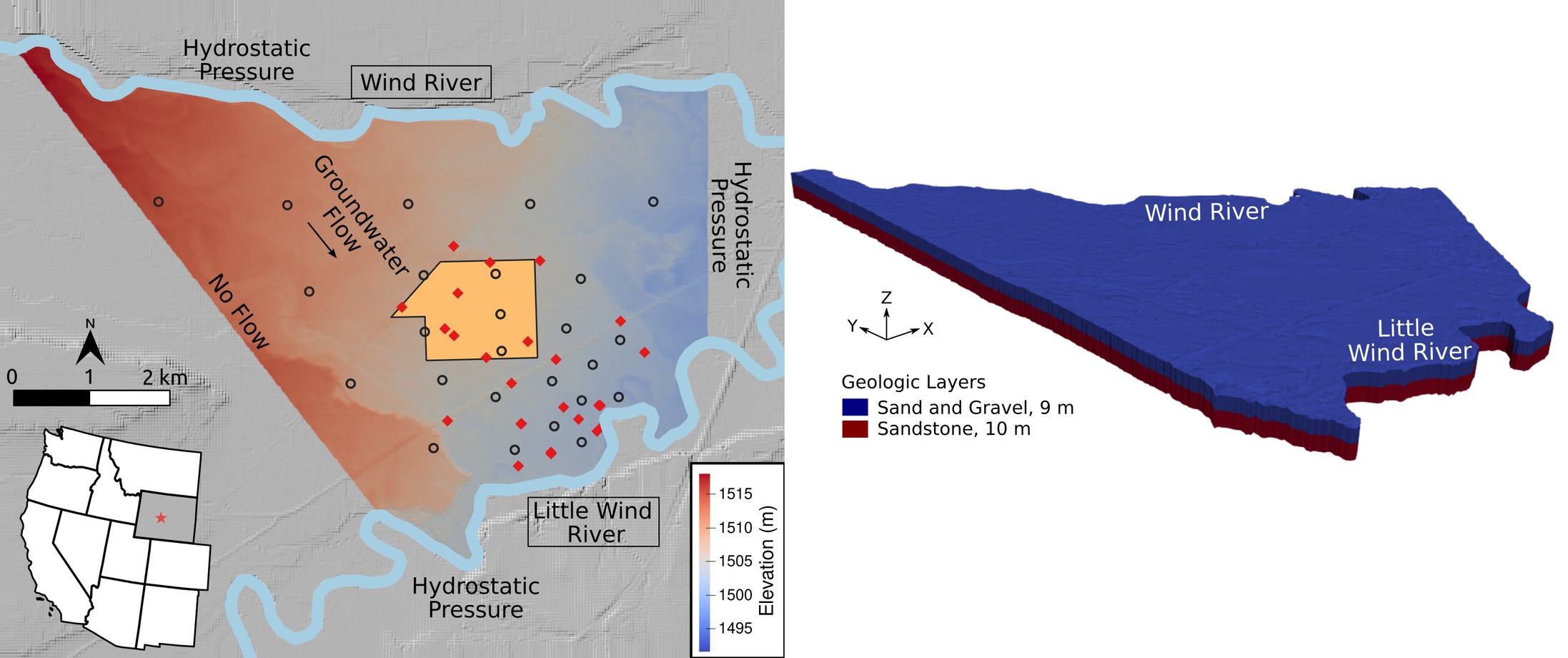October 17, 2022
Improving Groundwater Transport Predictions with Machine Learning
Combining natural tracers and machine learning to provide advanced groundwater transport forecasts.

Numerical model mesh and map of the Riverton study site located in west-central Wyoming on the Wind Indian Reservation.
[Reprinted under a Creative Commons Attribution 4.0 International License (CC BY 4.0) from Thiros, N. E., et al. "Quantifying Subsurface Parameter and Transport Uncertainty Using Surrogate Modelling and Environmental Tracers." Hydrological Processes 36 (11), e14743. DOI:10.1002/hyp.14743.]
The Science
Because the geologic structure of the subsurface as well as groundwater levels and characteristics are rarely well defined, simulation results of groundwater movement from a single groundwater transport model are almost guaranteed to be wrong. To produce the most plausible and realistic range of predictions, groundwater transport models must be run tens to hundreds of thousands of times using the most likely configurations of groundwater properties. As groundwater transport models become more complex and accurately simulate real physics, they become more computationally expensive, and the time required to run simulations becomes unreasonable. To overcome this limitation, a team of researchers “taught” an artificial neural network (ANN) to reproduce the results of a physics-based model over a broad range of groundwater system properties. To calculate the correct predictive uncertainty of groundwater transport using the ANN, the ANN outputs were compared with field data from natural tracer concentrations.
The Impact
This study demonstrated that the reactive transport model was not good at predicting the transport of specific groundwater constituents, even though the model was able to reproduce the energy required to move the groundwater through the subsurface. The use of natural chemicals identified a flawed groundwater model. Without using these natural chemicals, this flaw would have been invisible, and the model would have been unable to provide accurate predictions.
Summary
Quantifying uncertainty in reactive transport model predictions is extremely hard due to the high computational cost of running thousands of realizations of the model. While the gold standard of Bayesian methods for modeling are sought, they are completely intractable in this case with the use of physics-based reactive transport models. In this study, a team of researchers combined physics-based groundwater reactive transport modeling with machine learning techniques to quantify hydrogeological model and solute transport predictive uncertainties. An ANN was trained on a dataset of groundwater hydraulic heads and tritium (3H) concentrations generated using a high-fidelity, physics-based groundwater reactive transport model. After using the trained ANN as a surrogate model to reproduce the input-output response of the high-fidelity reactive transport model, the team quantified the posterior distributions of hydrogeological parameters and hydraulic forcing conditions using Markov-chain Monte Carlo (MCMC) calibration against field observations of groundwater hydraulic heads and 3H concentrations. The methodology was then demonstrated with a model application that predicted Chlorofluorocarbon-12 (CFC-12) solute transport at a contaminated site in Wyoming. Results showed that including 3H observations in the calibration dataset reduced uncertainty in the estimated permeability field and infiltration rates compared to calibration against hydraulic heads alone.
Principal Investigator
William Payton Gardner
University of Montana
payton.gardner@umontana.edu
Program Manager
Jennifer Arrigo
U.S. Department of Energy, Biological and Environmental Research (SC-33)
Environmental System Science
jennifer.arrigo@science.doe.gov
Paul Bayer
U.S. Department of Energy, Biological and Environmental Research (SC-33)
Environmental System Science
paul.bayer@science.doe.gov
Funding
This research was supported by the Established Program to Stimulate Competitive Research (EPSCoR) and Biological and Environmental Research (BER) Program within the U.S. Department of Energy’s (DOE) Office of Science under Award Number DE-SC0021088. Support was also received from DOE Nuclear Energy under Award Number DE-NE0008786.
References
Thiros, N. E., et al. "Quantifying Subsurface Parameter and Transport Uncertainty Using Surrogate Modelling and Environmental Tracers." Hydrological Processes 36 (11), e14743 https://doi.org/10.1002/hyp.14743.

